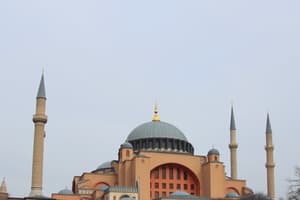Podcast
Questions and Answers
When did Constantinople, the wealthy eastern capital of the Roman Empire, finally fall to foreign conquest?
When did Constantinople, the wealthy eastern capital of the Roman Empire, finally fall to foreign conquest?
1453
Christian scholars fervently rejected all Greek and Roman philosophies because the philosophies were pagan.
Christian scholars fervently rejected all Greek and Roman philosophies because the philosophies were pagan.
False (B)
Why might some scholars assert that the mosaic blends Jesus and Sol Invictus?
Why might some scholars assert that the mosaic blends Jesus and Sol Invictus?
The figure in the mosaic is driving a chariot, similar to Sol Invictus on Constantine's shield, and the sun rays around Sol Invictus' head resemble the figure's halo in the mosaic.
Place the following events in chronological order: Central Asian Huns migrated into the Black Sea region, forcing the Goths to enter the Roman Empire as refugees.
Place the following events in chronological order: Central Asian Huns migrated into the Black Sea region, forcing the Goths to enter the Roman Empire as refugees.
Place these events in the establishment of Christianity in chronological order: Paul of Tarsus spread Christianity, Decius and Diocletian targeted Christians, Constantine issued the Edict of Milan, The Council of Nicea asserted Arianism as heresy.
Place these events in the establishment of Christianity in chronological order: Paul of Tarsus spread Christianity, Decius and Diocletian targeted Christians, Constantine issued the Edict of Milan, The Council of Nicea asserted Arianism as heresy.
At the time of the Great Persecution of 303, what portion of the Roman population was Christian?
At the time of the Great Persecution of 303, what portion of the Roman population was Christian?
Residents of Galilee felt differently about Roman rule: _____ participated in the Roman system and benefited from it, while _____ disliked it.
Residents of Galilee felt differently about Roman rule: _____ participated in the Roman system and benefited from it, while _____ disliked it.
Which of Diocletian's changes illustrated his adoption of the title dominus?
Which of Diocletian's changes illustrated his adoption of the title dominus?
What can one say about the relationship between the Pharisees and the origins of Christianity?
What can one say about the relationship between the Pharisees and the origins of Christianity?
How did the economy of the western empire change in the century after the barbarian invasions?
How did the economy of the western empire change in the century after the barbarian invasions?
What was the poorer half of the empire where the city of Ravenna became its capital?
What was the poorer half of the empire where the city of Ravenna became its capital?
What part of the empire was more populous, with most of the Roman military stationed here?
What part of the empire was more populous, with most of the Roman military stationed here?
Who was Pontius Pilate?
Who was Pontius Pilate?
Who was Jesus?
Who was Jesus?
Who was Herod?
Who was Herod?
Who was Paul?
Who was Paul?
Place the succession crises of the second and third centuries and their policy changes in chronological order.
Place the succession crises of the second and third centuries and their policy changes in chronological order.
Flashcards are hidden until you start studying
Study Notes
Fall of Constantinople
- Constantinople fell to foreign conquest in 1453, marking the end of the Byzantine Empire.
Views on Greek and Roman Philosophy
- Christian scholars did not entirely reject Greek and Roman philosophies, which indicates a level of intellectual engagement with these ideas.
Mosaic Interpretation
- Scholars note similarities between the mosaic figure and Sol Invictus, such as chariot-driving and sun rays resembling a halo.
Decline of the Western Roman Empire
- The Huns' migration into the Black Sea forced Gothic refugees into the Roman Empire.
- The Gothic victory over the Roman army at the Battle of Adrianople exemplified the Empire's military decline.
- Alaric, initially a Roman military commander, sacked Rome before moving to Spain.
Establishment of Christianity
- Paul of Tarsus was instrumental in spreading Christianity throughout the eastern Mediterranean.
- Key persecutions during the reigns of Decius and Diocletian targeted Christians but did not eradicate the faith.
- The Edict of Milan (issued by Constantine) granted religious freedom to Roman citizens.
- The Council of Nicea established a Christian creed and condemned Arianism as heretical.
- Thomas thinkers like Augustine and Benedict shaped Christian theology and monasticism.
Christian Population During Persecutions
- Less than 5% of the western Roman population and no more than 10% in the eastern regions identified as Christians by 303.
Discontent with Roman Rule
- Relationship dynamics in Galilee reflected differing views on Roman rule: Jewish elites benefited, while poorer inhabitants despised it.
- Tensions among Jewish groups revolved around religious interpretations, notably leading to conflicts involving Jesus and the establishment.
Diocletian's Reforms
- Diocletian adopted the title of dominus, altering traditional Roman governance, evident in his opulent lifestyle and the relocation of his capital to Nicomedia.
Pharisees and Christianity
- Pharisaic beliefs, such as life after death and awaiting a messiah, influenced early Christian thought. Followers of Jesus extended these concepts by declaring him the Messiah.
Economic Changes Post-Barbarian Invasions
- The western Roman Empire's economy suffered major declines, with notable decreases in population and overland trade after barbarian invasions.
Geographic and Military Dynamics
- Ravenna became the capital of the poorer western half of the Roman Empire, while the more populous eastern part housed most of the military forces.
Key Historical Figures
- Pontius Pilate served as governor of Galilee under Roman rule.
- Jesus was a Jewish preacher challenging the Temple priesthood's ideology.
- King Herod of Galilee aimed to maintain peaceful relations with local elites.
- Paul, a Hellenized Jew, played a crucial role in spreading early Christianity among Gentiles.
Studying That Suits You
Use AI to generate personalized quizzes and flashcards to suit your learning preferences.



